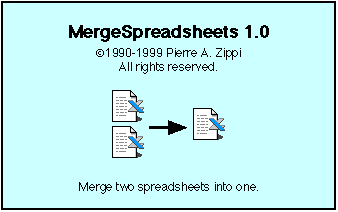

©1990-1999 Pierre A. Zippi. All rights reserved.
See MaxOS X compatible version: Merge Spreadsheets 2
Merge two spreadsheets into one without duplicating column categories.

| Use MergeSpreadsheets 1.0 to combine spreadsheet data without
identical column categories. MergeSpreadsheets 1.0 reads two tab-delimited
ASCII spreadsheet data files and saves a single tab-delimited ASCII spreadsheet
data file with merged columns.
The resulting file may be used with text, spreadsheet, statistics and plotting applications on any platform. The original files are left unaltered (unless you purposefully save the final data file with the exact same file name and location and authorize the system to replace the original file). Comment lines: If comment lines are present in the 1st spreadsheet, then comments will be saved in the line immediately below the column labels. Otherwise, data will follow immediately below the column labels. Comment lines start with the "#" symbol. The pound sign (#) is a reserved character indicating that the following text is a comment and not data. Note : The program assumes there may be duplicate columns, but that there are no duplicate rows. The merged spreadsheet is not sorted by rows. If your data is sequential data, then you should use a text or spreadsheet editor to sort the merged data file by the value in the first column. If your data has duplicate rows, you should also choose to average the duplicate rows if appropriate. Search and replace: A rudimentary (but fast) search and replace feature is provided for data files less than 32K in size. Use the search and replace feature to change abundance codes to numbers. For example, if the original data has "P" for present, you can change it to "1" so that the data can be processed by statistic and plotting applications that require numerical data. Once in spreadsheet format, the utility of the occurrence data is greatly enhanced. Use a proven commercial spreadsheet or statistics application to manipulate the data. Use WellPlot 2.0 (available from Pierre Zippi) to make attractive multi-track diagrams that can be incorporated into by virtually any Macintosh or PC document. Use Counter 3.0 for data acquistion. |
Merge Example:
Input #1:
Depth Sp.A Sp.B Sp.C 1000 10 5 10 2000 7 5 14 3000 3 3 13 4000 5 7 16 5000 10 5 11
Input #2:
Depth Sp.A Sp.D Sp.E 1500 3 2 1 2500 2 3 2 3500 13 4 16 4500 6 1 13 5500 8 3 22
Example of merged output:
This small example looks simple enough,Depth Sp.A Sp.B Sp.C Sp.D Sp.E 1000 10 5 10 0 0 2000 7 5 14 0 0 3000 3 3 13 0 0 4000 5 7 16 0 0 5000 10 5 11 0 0 1500 3 0 0 2 1 2500 2 0 0 3 2 3500 13 0 0 4 16 4500 6 0 0 1 13 5500 8 0 0 3 22
The time to merge 2 files each 200 rows x 200 columns is 15 seconds on a G3/266 (including file selection time).
Features:
Price: $75 US retail, if purchased separately. Included with WellPlot 2.0 software package.

Pierre A. Zippi
7518 Twin Oaks Court
Garland, Texas 75044
(972)-496-3642
email: paz@pazsoftware.com
Go to: PAZ Software Homepage